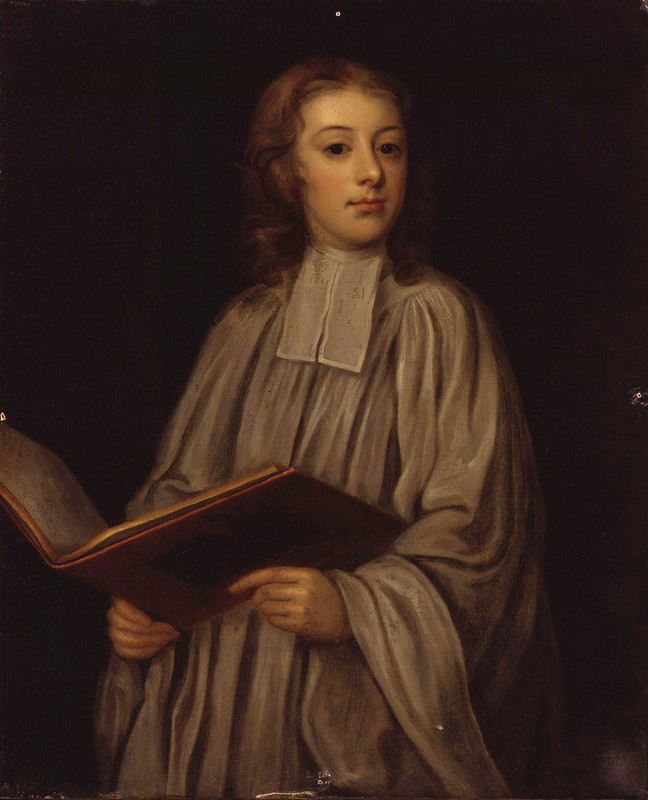William Croft (1678-1727)
- Suite in c
Performers: Cοlin Bοοth (harpsichord)
Painting: Unknown artist - William Croft
---
English organist and composer. He was a chorister in the Chapel Royal
under Blow, of whom, as appears from verses prefixed to Amphion anglicus
(1700), he was not only a pupil but a protégé. He was also deeply
influenced by Purcell, many of whose works he must have performed and
certainly preserved in manuscript copies from the 1690s. There is no
reason to reject the probability that he is the ‘Phillip Crofts’
mentioned in the parish archives of St Anne’s Church, Soho, as organist
from 1700. In that year he renewed his connection with the Chapel Royal
as Gentleman Extraordinary, sharing that post, together with the
reversion of a place as organist, with Jeremiah Clarke. In May 1704 they
jointly succeeded Francis Pigott as organist of the chapel, and when
Clarke died in 1707 the whole place fell to Croft. His anthems in
celebration of the battles of Blenheim and Ramillies show that he was
already by then supplementing Blow’s duties as a composer, and on Blow’s
death in 1708 he followed him not only as composer, Tuner of the Regals
and Organs, and Master of the Children of the Chapel Royal but also as
organist of Westminster Abbey. Rather curiously, at some time before
1712, he paid for the restoration of the monument in Norwich Cathedral
to William Inglott. In 1712 he relinquished his post at St Anne’s. In
July 1713 Croft took the Oxford degree of DMus, being the earliest
Oxford graduate in music relating to whom there survives solid extended
work submitted for the degree; this took the form of two odes for solo
voices, chorus and orchestra, With noise of cannon and Laurus cruentas,
celebrating the Treaty of Utrecht, and published as Musicus apparatus
academicus. Croft was the senior Chapel Royal composer at the time when
Handel began to find favour with Queen Anne, and even though there is no
evidence of friction it is not impossible that this imposing volume may
have seemed a means of maintaining the native composer’s standing.
In 1715 his stipend as Master of the Children of the Chapel Royal was
increased by £80 a year, his duties to include teaching the boys
reading, writing and arithmetic, as well as organ playing and
composition. From around this time until his death he enjoyed the
patronage of Sir John Dolben of Finedon, Northamptonshire, sub-dean of
the Chapel Royal (1712-17). Croft broke new ground in 1724 by the
publication of a handsome two-volume collection of his church music,
entitled Musica sacra (seeillustration), engraved and in the form of a
score rather than in parts, the advantages of which he cogently urged in
his preface. A copy of his ‘Proposals’ to subscribers is now in the New
York Public Library. A list dated 1726 shows that Croft was one of the
earliest members of the Academy of Vocal Music. He married in 1705, but
died childless and was buried close to Purcell in Westminster Abbey.
Hawkins (History, ii, 797) described him as a ‘grave and decent man’,
and the imposing format of his two chief publications together with the
nature of his music indicates that he took his position seriously. As a
composer Croft was both a staunch preserver of tradition and an
assimilator of new techniques. Many of his works were modelled on
specific compositions by Purcell; yet there is evidence that he revised
his own Te Deum in D, which was clearly based on Purcell’s 1694
composition, after having heard Handel’s ‘Utrecht’ setting of 1713.
Enough of Croft’s songs and instrumental music is dated to justify the
view that these branches of composition did not occupy him much after
his third decade. His string pieces for the theatre are agreeable if not
specially noteworthy, while his harpsichord music is smoother and more
regularly turned than that of Blow, with whom Croft, together with
others of Blow’s scholars, combined in a publication of 1700.

Cap comentari:
Publica un comentari a l'entrada